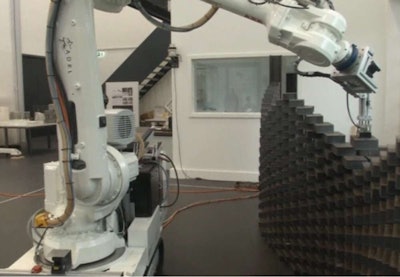
These multi-jointed arms reach, swing, dance and swivel around to weld dozens of joints on an assembly, often within just a few seconds. The robot always lays down a perfect bead or tack, it works many times faster than a human, and it never takes sick days or vacations. That’s why they’re used in almost every factory where welding happens in the world today.
Now imagine putting that same robotic-arm superstructure on a set of rubber tracks, configure the tool end to pick up brick or block rather than weld. According to a report from Reuters, that’s exactly what researchers have done in Switzerland with their In-situ Fabricator, or IF Mobile Robot. See the video below.
In the video the researchers raise a few issues to be resolved and say it may be eight or ten years before such robots will go to work on building construction jobsites. I think they’re wrong. Whatever challenges these prototypes face now can be easily engineered out of the jobsites. And I fully believe that something like the Swiss IF mobile robot will be in commercial use within three years. Here’s why:
I framed homes back in the late 70s and early 80s. The builder that gave us the most work, Ray Ellison Homes, was always trying different ways to modularize the process. Instead of stick framing, they’d give us pre-framed segments that we’d stand up and nail together. Other times they would pre-frame a segment and put the siding on at the factory and we’d stand that up. Ray Ellison was ahead of his time in trying to find a more efficient system, but regardless of the system all the houses took about the same amount of time to frame.
What really ate up time was framing the roof. With trusses you had to get those beastly heavy pieces stacked up and laid out flat on the walls, then stand them up one at a time with one guy in the middle and two guys on either end to toe nail the truss to the top plate. It was slow and dangerous, with all three carpenters 10 feet off the ground trying to wrestle with wobbly trusses that may weigh 200 pounds each.
Now imagine a robotic telehandler with an adapted front end that simply places the truss on the right spot on the top plate. Or a robotic rack placed on the walls that moves and braces each truss into position hydraulically. Next you have another robot that moves along a track on the ground and toenails each truss to the top plate.
Instead of three or four men taking an entire afternoon to do this, imagine a pair of robots doing the same work, in an hour, 90 minutes tops. The technology to do this is already here. It just needs to be configured specific to the application. The only thing I can see that would have to change on the job would be to keep the site level and free from debris to allow a tracked robot to move about or rails to be laid for the robots to run on.
The thing to remember about robotic technology is that it’s best used for repetitive tasks. So laying bricks and block–a sure fire winner. Framing rafters and trusses? Oh yeah!
Back in the day we put 50 to 100 pounds of nails into every house we framed. And if the compressor blinked out, somebody cut the air hose or the guns jammed, we’d have to pound in every one of those nails by hand. If Ray Ellison were alive today, he’d be designing robots.
One of the things that always ticked me off about builders is that most were too cheap to strap the roof framing to the wall framing. These lightweight aluminum straps cost less than $1 each. You only need one every third stud, but in high winds they can and often do keep a house from coming apart. They’re not required by code except in Florida and along some coastal areas, but otherwise most builders won’t use them. Why? Because each strap requires six to eight nails, precisely driven through holes in the strap and doing a whole house could take one carpenter a half a day. Applications like these are perfect for robots.
Think about what you do and what’s the most repetitive task your workers perform. Then start thinking about how a robot could do it better. It’s going to happen and sooner than anyone imagines.












